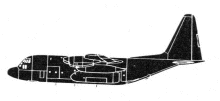Incident Overview

Description
A Lockheed L-100 Hercules aircraft, registered N403LC, operated by Lynden Air Cargo for PNGAir, conducted a charter flight from Komo Airport to Jacksons International Airport in Papua New Guinea. The flight crew consisted of a pilot in command (PIC), copilot, load master, and two flight engineers. The Hercules landed on runway 14L at 15:10 local, turned right onto taxiway M and continued taxiing to Bay 23, crossing runway 14R and taxiway A. The adjacent bays, Bay 22 and Bay 24 were occupied by a Boeing 737-800, registered P2-PXE, operated by Air Niugini and a Canadian registered Basler BT-67 aircraft respectively. Marshalling guidance was provided at Bay 23 by the operator’s ground personnel. At 15:15, as the PIC was manoeuvring the aircraft slightly to the left to prepare the aircraft to make a right turn and position its aft end to face the airport access gate to the cargo yard, the radius of turn took it past the wing tip of the Boeing 737. The Boeing 737 was stationary and unoccupied on the apron. The leading edge of the left wing of the Hercules impacted the right winglet of the Boeing 737 causing significant damage to both aircraft. The investigation found that the PIC did not taxi via the Bay 23 centreline, but was 15.7 metres to the left of the line. Bay 23 is designed for Boeing 747 parking which provides for a wingspan 24 metres longer than the Hercules. If the Hercules had been taxiing on the Bay 23 centreline and if the parked Boeing 737 was on the Bay 22 centreline there would still have been a safety margin of 8 metres between the wing tips. The PICs decision to taxi the Hercules left of the Bay 23 centreline was based on his decision to turn the aircraft through 180 degrees onto the bay in order to have its aft cargo ramp facing the gate to the cargo yard. In order to make such a manoeuvre the PIC considered it necessary to manoeuvre the aircraft left before making the 180-degree turn. He misjudged the turning radius and distance between the wingtips. In taking his attention away from the marshaller, he deprived himself of the crucial guidance that could have prevented the accident.
Primary Cause
Deviation from standard taxi procedures and misjudgment of turning radius, leading to a collision.Deviation from standard taxi procedures and misjudgment of turning radius, leading to a collision.Share on:


